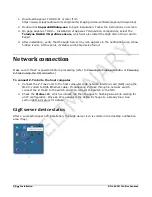
16
•
Theory of operation
Z-Trak2 3D Profiler Sensors
Theory of operation
How a 3D profiler sensor works
There are three components to the Z-Trak2 profiler:
•
a laser source (blue or red depending on model) that emits a laser line projected on the object.
•
a 2D sensor that captures the light reflected from the object. A narrow bandpass optical filter
tuned to the laser color is placed over the 2D sensor view window to minimize ambient light
interference.
•
Embedded computing capability to process the captured image into height measurements at a
very high rate.
Figure 4. The Z-Trak2 3D laser profiler showing the laser window and the 2D sensor window.
Z-Trak2 illuminates an object with a plane of light. The light reflected by the projected line on the
object is captured on the 2D sensor, which forms a profile. After determining the position of the
laser line reflected on the area sensor, the profiler uses triangulation to precisely translate this
information into 3D, real-world measurements. The captured data is output as a set of height
values for each point of a profile.
To capture an entire surface, a sequence of profiles must be obtained by moving the object relative
to the profiler. The resulting sequence of profiles is a representation of the object's surface.
















































